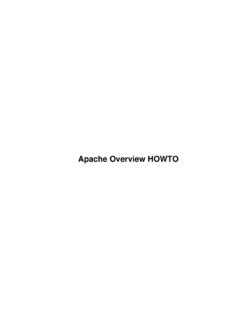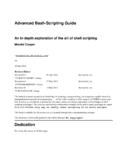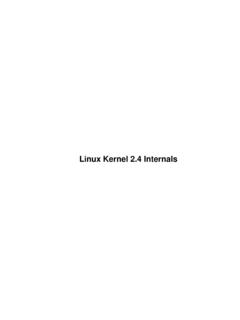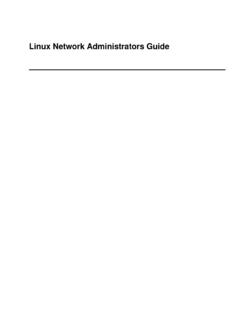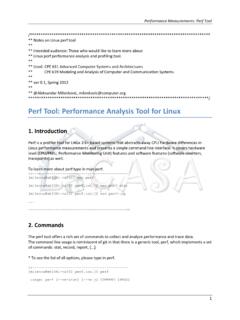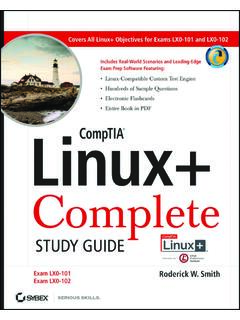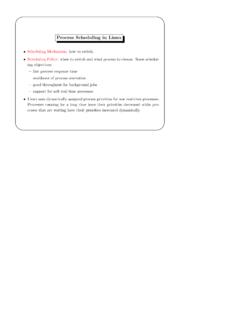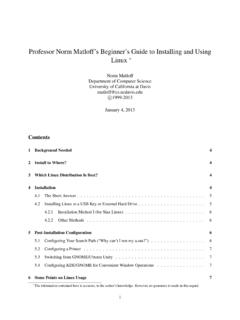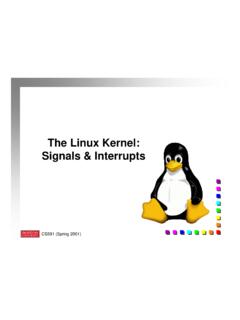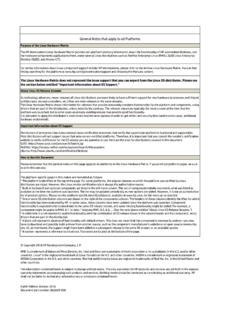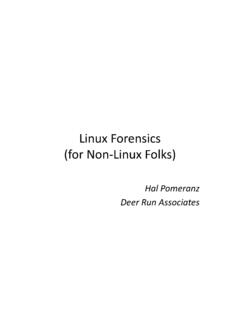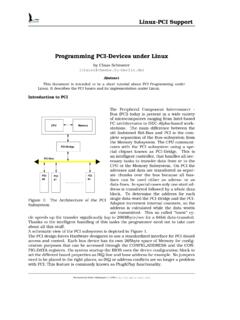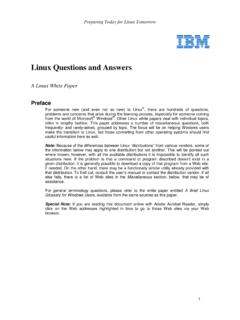Transcription of The Linux System Administrator's Guide
1 The Linux System Administrator's Guide Version Lars Wirzenius <Email address removed by request>. Joanna Oja <Current email address unknown>. Stephen Stafford Alex Weeks An introduction to System administration of a Linux System for novices. Copyright 1993 1998 Lars Wirzenius. Copyright 1998 2001 Joanna Oja. Copyright 2001 2003 Stephen Stafford. Copyright 2003 2004 Stephen Stafford & Alex Weeks. Copyright 2004 Present Alex Weeks. Trademarks are owned by their owners. Permission is granted to copy, distribute and/or modify this document under the terms of the GNU Free Documentation License, Version or any later version published by the Free Software Foundation; with no Invariant Sections, no Front Cover Texts, and no Back Cover Texts. A copy of the license is included in the section entitled "GNU Free Documentation License". The Linux System Administrator's Guide Table of Contents About This 1.
2 Joanna's Stephen's Alex's 2. Revision 3. Source and pre formatted versions 4. Typographical Chapter 1. Linux or GNU/ Linux , that is the Chapter 2. Overview of a Linux Various parts of an operating Important parts of the Major services in a UNIX Logins from Periodic command execution: cron and Graphical user Network Network file The filesystem Chapter 3. Overview of the Directory The root The /etc The /dev The /usr The /var The /proc Chapter 4. Hardware, Devices, and Hardware The MAKEDEV The mknod The lspci The lsdev The lsusb The lsraid The hdparm More Hardware i The Linux System Administrator's Guide Table of Contents Chapter 4. Hardware, Devices, and Tools Kernel Chapter 5. Using Disks and Other Storage Two kinds of Hard Storage Area Networks Network Attached Storage CD The MBR, boot sectors and partition Extended and logical Partition Partitioning a hard Device files and What are filesystems?
3 36. Filesystems Which filesystem should be used?..39. Creating a Filesystem block Filesystem Mounting and Filesystem Checking filesystem integrity with Checking for disk errors with Fighting fragmentation?..46. Other tools for all Other tools for the ext2/ext3 Disks without Allocating disk Partitioning Logical Volume Manager (LVM)..50. Space Examples of hard disk Adding more disk space for Tips for saving disk ii The Linux System Administrator's Guide Table of Contents Chapter 6. Memory What is virtual memory?..52. Creating a swap Using a swap Sharing swap spaces with other operating Allocating swap The buffer Chapter 7. System System The top The iostat The ps The vmstat The lsof Finding More Filesystem The df The du Monitoring The who The ps command again!..64. The w The skill nice and Chapter 8. Boots And An overview of boots and The boot process in closer A Word About More about Single user Emergency boot Chapter 9.
4 Init comes Configuring init to start getty: the /etc/inittab Run Special configuration in / Booting in single user Chapter 10. Logging In And Logins via Logins via the What login X and iii The Linux System Administrator's Guide Table of Contents Chapter 10. Logging In And Out Access Shell Chapter 11. Managing user What's an account?..79. Creating a /etc/passwd and other informative Picking numeric user and group Initial environment: / Creating a user by Changing user Removing a Disabling a user Chapter 12. On the importance of being backed Selecting the backup Selecting the backup Simple Making backups with Restoring files with Multilevel What to back Compressed Chapter 13. Task Automation To Be Chapter 14. Keeping The concept of The hardware and software Showing and setting When the clock is NTP Network Time Basic NTP NTP Some known NTP NTP Chapter 15. System Logs To Be Chapter 16.
5 System Updates To Be Chapter 17. The Linux Kernel Chapter 18. Finding Newsgroups and Mailing Finding The Right iv The Linux System Administrator's Guide Table of Contents Chapter 18. Finding Help Before You Writing Your Formatting Your Follow More Be Type Properly, in Port Keep it in the Stay On Hacking, Cracking, Phreaking, Round Further Appendix A. GNU Free Documentation APPLICABILITY AND VERBATIM COPYING IN COMBINING COLLECTIONS OF AGGREGATION WITH INDEPENDENT FUTURE REVISIONS OF THIS ADDENDUM: How to use this License for your Glossary (DRAFT, but not for long hopefully)..111. Index v The Linux System Administrator's Guide Table of Contents Glossary (DRAFT, but not for long hopefully). vi About This Book "Only two things are infinite, the universe and human stupidity, and I'm not sure about the former." Albert Einstein 1. Acknowledgments Joanna's acknowledgments Many people have helped me with this book, directly or indirectly.
6 I would like to especially thank Matt Welsh for inspiration and LDP leadership, Andy Oram for getting me to work again with much valued feedback, Olaf Kirch for showing me that it can be done, and Adam Richter at Yggdrasil and others for showing me that other people can find it interesting as well. Stephen Tweedie, H. Peter Anvin, Remy Card, Theodore Ts'o, and Stephen Tweedie have let me borrow their work (and thus make the book look thicker and much more impressive): a comparison between the xia and ext2 filesystems, the device list and a description of the ext2 filesystem. These aren't part of the book any more. I am most grateful for this, and very apologetic for the earlier versions that sometimes lacked proper attribution. In addition, I would like to thank Mark Komarinski for sending his material in 1993 and the many System administration columns in Linux Journal. They are quite informative and inspirational.
7 Many useful comments have been sent by a large number of people. My miniature black hole of an archive doesn't let me find all their names, but some of them are, in alphabetical order: Paul Caprioli, Ales Cepek, Marie France Declerfayt, Dave Dobson, Olaf Flebbe, Helmut Geyer, Larry Greenfield and his father, Stephen Harris, Jyrki Havia, Jim Haynes, York Lam, Timothy Andrew Lister, Jim Lynch, Michael J. Micek, Jacob Navia, Dan Poirier, Daniel Quinlan, Jouni K Sepp nen, Philippe Steindl, Stotte. My apologies to anyone I have forgotten. Stephen's acknowledgments I would like to thank Lars and Joanna for their hard work on the Guide . In a Guide like this one there are likely to be at least some minor inaccuracies. And there are almost certainly going to be sections that become out of date from time to time. If you notice any of this then please let me know by sending me an email to: I will take virtually any form of input (diffs, just plain text, html, whatever), I am in no way above allowing others to help me maintain such a large text as this :).
8 Many thanks to Helen Topping Shaw for getting the red pen out and making the text far better than it would otherwise have been. Also thanks are due just for being wonderful. About This Book 1. The Linux System Administrator's Guide Alex's Acknowledgments I would like to thank Lars, Joanna, and Stephen for all the great work that they have done on this document over the years. I only hope that my contribution will be worthy of continuing the work they started. Like the previous maintainers, I openly welcome any comments, suggestions, complains, corrections, or any other form of feedback you may have. This document can only benefit from the suggestions of those who use it. There have been many people who have helped me on my journey through the "Windows Free" world, the person I feel I need to thank the most is my first true UN*X mentor, Mike Velasco. Back in a time before SCO became a "dirty word", Mike helped me on the path of tar's, cpio's, and many, many man pages.
9 Thanks Mike! You are the 'Sofa King'. 2. Revision History Revision History Revision 2001 12 03 Revised by: SS. Revision 2003 11 18 Revised by: AW. 1. Added a section on NTP. 2. Cleaned some SGML. 3. Added ext3 to the filesystem section Revision Revised by: AW. 1. Cleaned some SGML code, changed doctype to , and added id tags 2. Updated section on filesystem types, and Filesystem comparison 3. Updated partition type section 4. Updated section on creating partitions 5. Wrote section on Logical Volume Manager (LVM). 6. Updated section on space allocation 7. Added chapter on System Monitoring 8. Added more command line utilities 9. Verified Device list 10. Modified email address for Authors 11. Added references to more in depth documents where applicable 12. Added notes on upcoming sections 13. Indexed chapters 1 4, & part of 5. 14. Updated Misc Information throughout the book 3. Source and pre formatted versions available The source code and other machine readable formats of this book can be found on the Internet via anonymous FTP at the Linux Documentation Project home page , or at the home page of this book at This book is available in at least it's SGML source, as well as, HTML and PDF formats.
10 Other formats may be available. About This Book 2. The Linux System Administrator's Guide 4. Typographical Conventions Throughout this book, I have tried to use uniform typographical conventions. Hopefully they aid readability. If you can suggest any improvements please contact me. Filenames are expressed as: /usr/share/doc/foo. Command names are expressed as: fsck Email addresses are expressed as: URLs are expressed as: I will add to this section as things come up whilst editing. If you notice anything that should be added then please let me know. About This Book 3. Chapter 1. Introduction "In the beginning, the file was without form, and void; and emptiness was upon the face of the bits. And the Fingers of the Author moved upon the face of the keyboard. And the Author said, Let there be words, and there were words.". The Linux System Administrator's Guide , describes the System administration aspects of using Linux .

